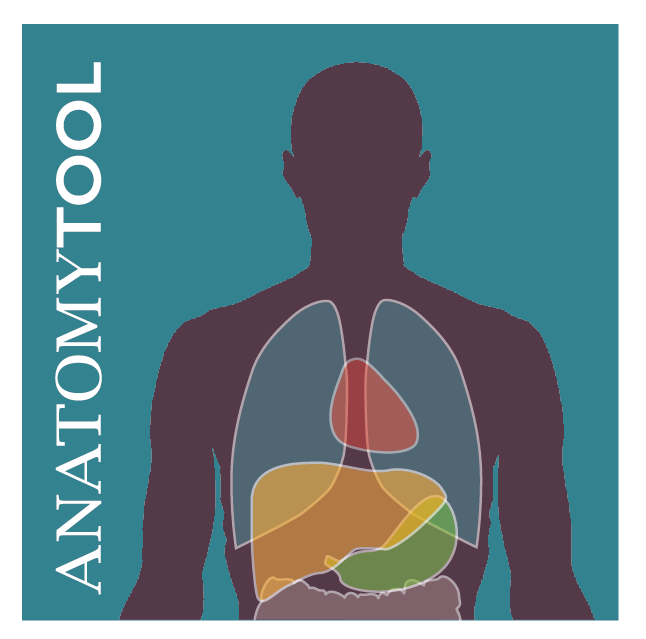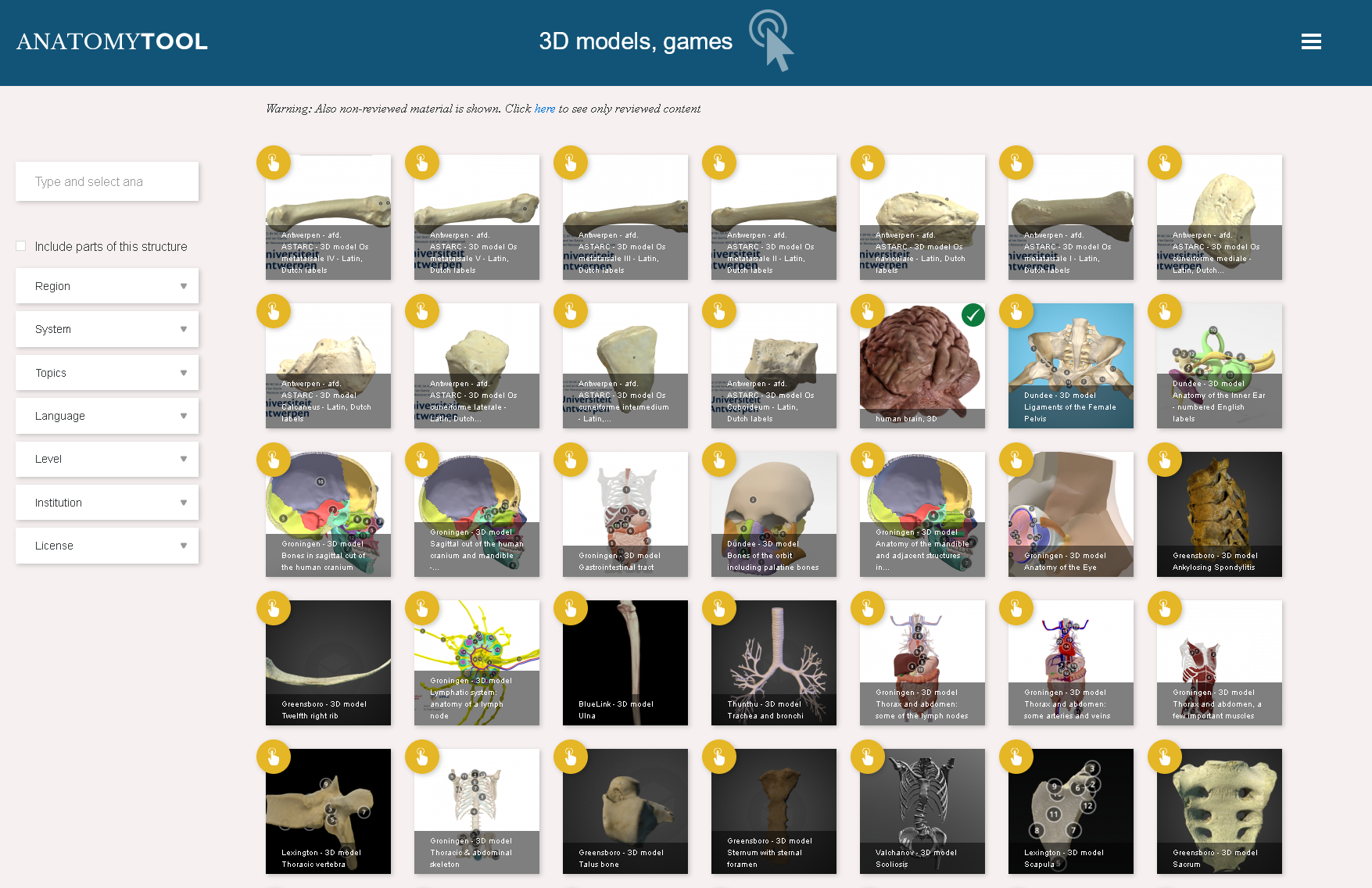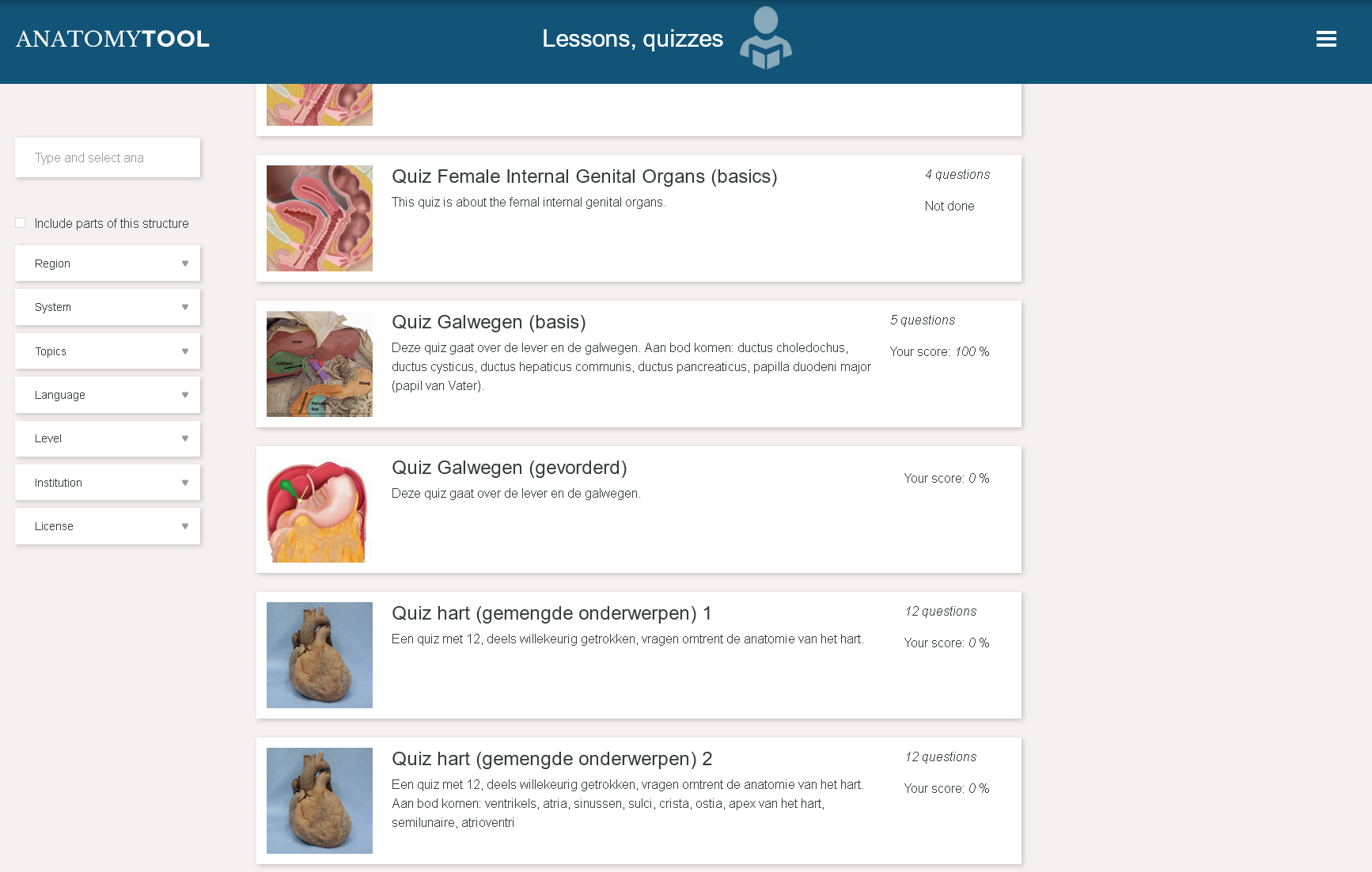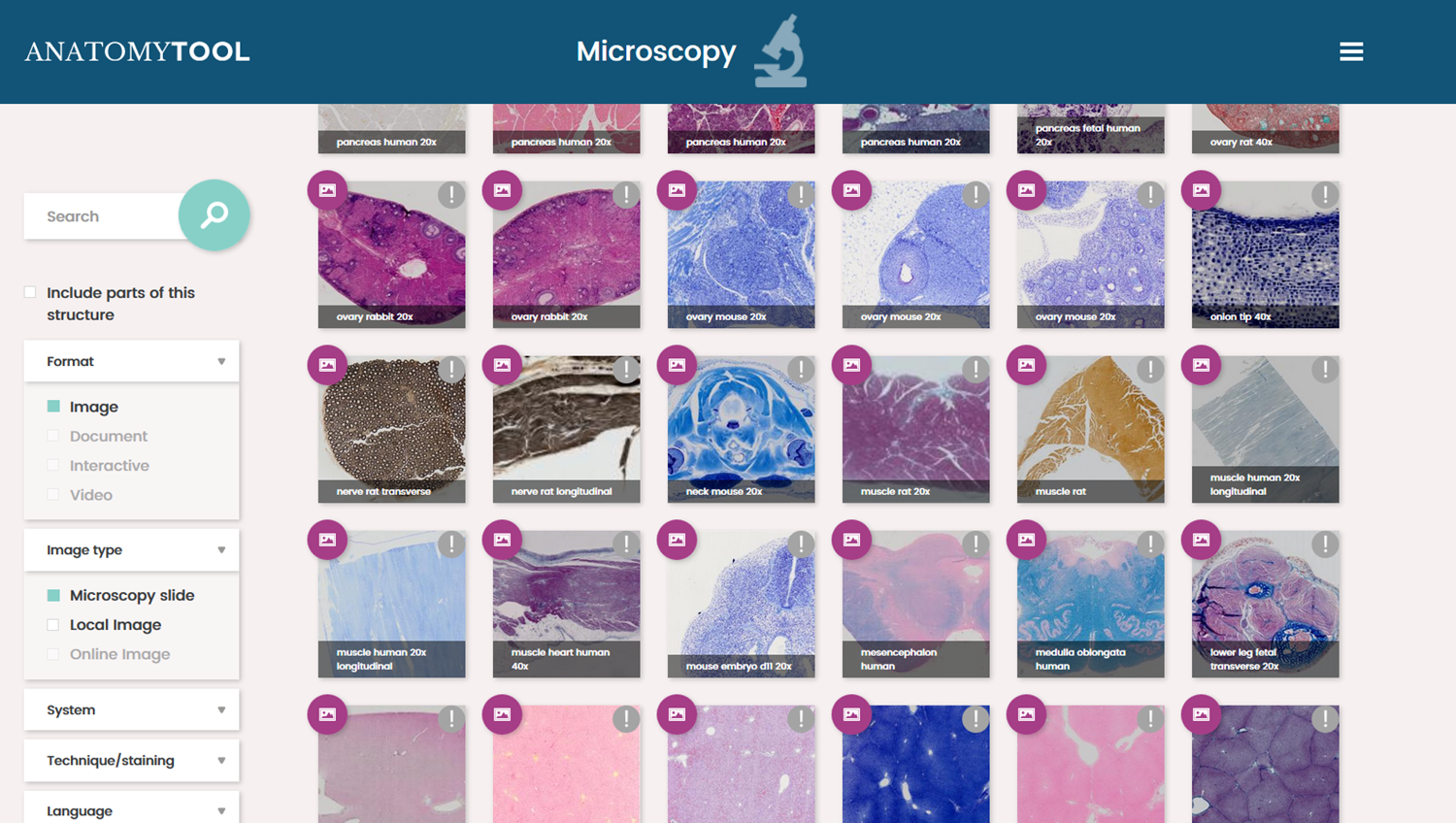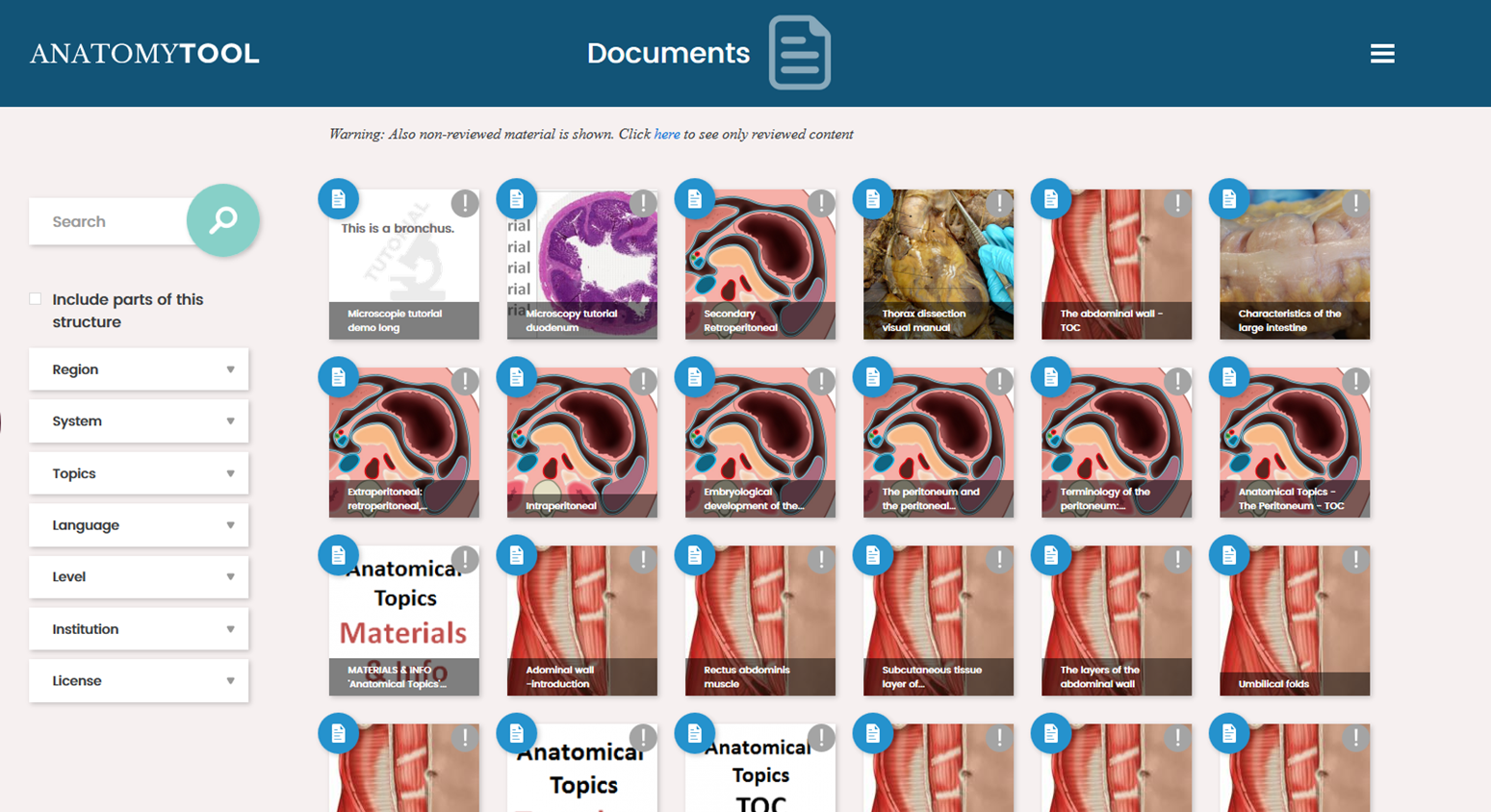English version, see below
AnatomyTOOL platform: http://AnatomyTOOL.org
AnatomyTOOL is een project en een gelijknamig platform met als doel het verzamelen, ontsluiten en uitwisselen van anatomie leermaterialen met een open licentie.
Het wordt gedragen door de Nederlands/Vlaamse Anatomen Vereniging (NAV) en ontvangt steun en bijdragen van de afdelingen anatomie in Nederland en Vlaanderen. Het is opgezet met subsidies van het Min. van Onderwijs, in het kader van het Stimuleringsproject Open Online Onderwijs (zie onder)
Het AnatomyTOOL platform bevat open afbeeldingen, oefenvragen en -quizzen, video’s, 3D modellen en documenten die gebruikt kunnen worden bij het leren van anatomie.
Doelgroepen zijn docenten anatomie en studenten van gezondheidszorgopleidingen. Docenten kunnen bijv. afbeeldingen verkregen van AnatomyTOOL gebruiken in het lesmateriaal wat ze maken. Ook kunnen ze (bestaande of zelf gemaakte) oefenquizzen op AnatomyTOOL aanbieden aan hun studenten. Studenten kunnen oefenquizzen doen, of tutorials, video’s, modellen of afbeeldingen bekijken.
De materialen hebben overwegend een Creative Commons licentie, danwel zijn in het Publieke Domein. Een zeer klein deel is alleen open toegang (gratis bekijken) beschikbaar. De materialen zijn deels bijgedragen door de afdelingen anatomie en deels verzameld van andere bronnen. Verwijzingen naar de items worden automatisch opgenomen op EduSources.
Binnen de NAV is een werkgroep van anatomen, informatiespecialisten en studenten die zich bezighoudt met het onderhoud van het platform, collectie uitbreiding en publiciteit rondom AnatomyTOOL. Geïnteresseerden om betrokken te worden bij, of bij te dragen aan AnatomyTOOL zijn welkom. (zie: contact)
‘TOOL’ staat voor ‘Topic Oriented Open Learning’ (platform) wat de drie belangrijkste kenmerken aanduidt: gericht op één domein (in dit geval anatomie), op open materiaal en op leren. Deze formule kan ook in andere disciplines worden toegepast, als men interesse heeft zo’n platform op te zetten, is de platform-code open source te verkrijgen (zie: contact).
Tot nu toe ontvingen het project en samenhangende vervolgprojecten de volgende subsidies:
• 2015 Topic Oriented Open Learning (TOOL) – platform in de Anatomie
• 2018 Open Anatomie Leermaterialen
• 2022 Open anatomisch 3D-model in het onderwijs
Socials:
Instagram, Facebook, LinkedIn
Contact:
voorzitter van de NAV werkgroep AnatomyTOOL (momenteel Paul Gobée, o.p.gobee@lumc.nl)
Meer informatie over AnatomyTOOL is hier.
Een impressie van de collecties op AnatomyTOOL: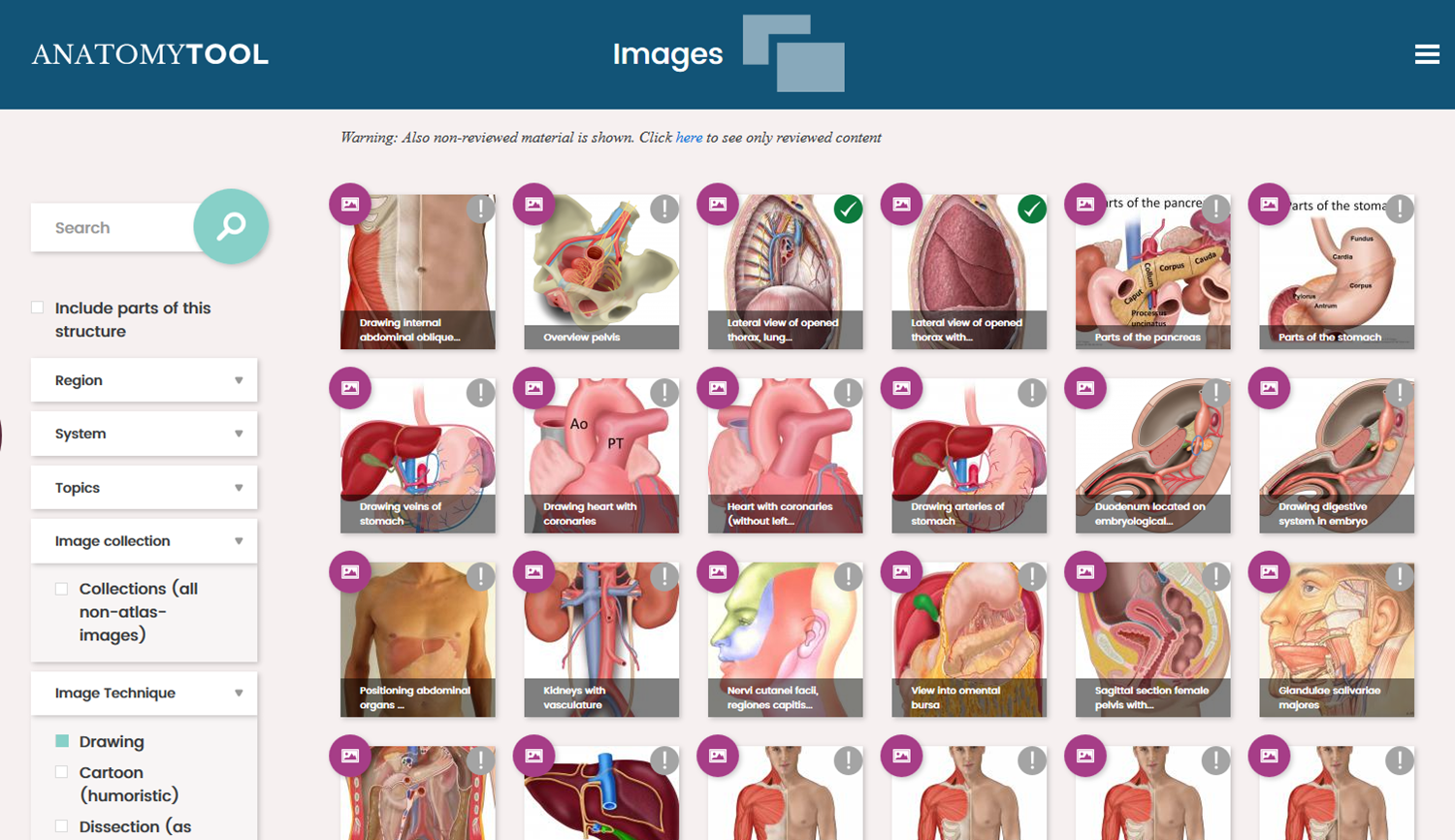
Project ‘Topic Oriented Open Learning (TOOL) – platform in de Anatomie‘ (TOOL1)
Tussen 2015 en 2017 werd het AnatomyTOOL platform ontwikkeld. Op het platform werden door de afdelingen anatomie beschikbaar gesteld: o.a. >60 tekeningen, >300 vragen (NB: log in), 9 quizzen, 220 microscopische coupes, >80 documenten/pagina’s en 50 video’s (aantallen medio 2018).
Meer info: zie archief AnatomyTOOL (in rechter sidebar): ‘2015 Project TOOL 1- platform’
Project ‘Open Anatomie Leermaterialen‘ (TOOL2)
In dit project (sept 2018- sept 2020) is er een forse opschaling in content gemaakt door een nieuw ontvangen subsidie voor het ontwikkelen en ontsluiten van anatomische tekeningen, 3D modellen, embryologie-, en klinisch anatomisch leermateriaal. In dit project werken verschillende Nederlandse (AUMC, LUMC, UM, UMCG) en Vlaamse universiteiten (Gent, Hasselt, Leuven) samen. Verder wordt dit project gesteund door de Nederlandse Anatomen Vereniging.
Op het end van het project waren er:
-
-
- 2900 afbeeldingen, Zie op AnatomyTOOL site (wisselende CC licentie of publiek domein)
- 1100 vragen in 175 quizzen (100NL, 75 Eng) Zie op AnatomyTOOL site (Meesten CC BY NC SA)
- 200 3D modellen Zie op AnatomyTOOL site (wisselende CC licentie)
- 125 video-tutorials (35 video-tutorials: Zie op AnatomyTOOL site;
- 92 video-tutorials met 3D-model: Zie op AnatomyTOOL site (BY NC SA, BY NC ND, BY SA)
- 160 microscopie coupes Zie op AnatomyTOOL site (CC BY NC SA)
- 50 teksten en readers, Zie op AnatomyTOOL site) (wisselende CC licentie)
- 100 referenties zowel op Zie op AnatomyTOOL site (naar externe sites en e-learning) als verspreid over de secties documenten, video’s, 3D-modellen, alsmede interne voorselecties onder de titel ‘Collections’: Zie op AnatomyTOOL site
-
Meer info: zie archief AnatomyTOOL (in rechter sidebar): ‘2018 Project TOOL 2- Collectie’
Project ‘Open anatomisch 3D-model in het onderwijs‘ (TOOL3)
Van 2022-2024 werken de afdelingen anatomie van UUMC, Maastricht Univ, LUMC en Kulak Leuven Univ samen aan het anatomisch corrigeren en voor het onderwijs bruikbaar maken van het wereldwijd (vooralsnog) enige open 3D model van de mens. https://www.surf.nl/open-anatomisch-3d-model-in-het-onderwijs
English version
AnatomyTOOL
AnatomyTOOL at http://AnatomyTOOL.org
AnatomyTOOL platform: http://AnatomyTOOL.org
AnatomyTOOL is a project and a platform of the same name with the aim of collecting, making available and exchanging anatomy learning materials with an open license.
It is supported by the Dutch/Flemish Anatomists Association (NAV) and receives support and contributions from the anatomy departments in the Netherlands and Flanders. It was set up with subsidies from the Min. of Education, in the context of the Open Online Education Incentive Project (see below)
The AnatomyTOOL platform contains open images, practice questions and quizzes, videos, 3D models and documents that can be used when learning anatomy.
Target groups are anatomy teachers and students of healthcare courses. Teachers can, for example, use images obtained from AnatomyTOOL in the teaching material they create. They can also offer (existing or self-made) practice quizzes on AnatomyTOOL to their students. Students can take practice quizzes, or view tutorials, videos, models or images.
The materials mainly have a Creative Commons license or are in the Public Domain. A very small portion is only open access (free viewing) available. The materials are partly contributed by the anatomy departments and partly collected from other sources. References to the items are automatically included on EduSources.
Within the NAV there is a working group of anatomists, information specialists and students that is concerned with the maintenance of the platform, collection expansion and publicity surrounding AnatomyTOOL. Those interested in becoming involved or contributing to AnatomyTOOL are welcome. (see: contact)
‘TOOL’ stands for ‘Topic Oriented Open Learning’ (platform) which indicates the three most important characteristics: focused on one domain (in this case anatomy), on open material and on learning. This formula can also be applied in other disciplines; if one is interested in setting up such a platform, the platform code is available open source (see: contact).
To date, the project and related follow-up projects have received the following grants:
• 2015 Topic Oriented Open Learning (TOOL) – platform in Anatomy
• 2018 Open Anatomy Learning Resources
• 2022 Open anatomical 3D model in education
Socials:
Instagram, Facebook, LinkedIn
Contact:
chairman of the NAV working group AnatomyTOOL (currently Paul Gobée, o.p.gobee@lumc.nl)
More information about AnatomyTOOL can be found here.
TOOL1
The AnatomyTOOL platform was developed between 2015 and 2017. The departments of Anatomy published on the platform: >60 drawings, >300 questions (NB: sign in), 9 quizzes, 220 microscopic slides, >80 documents/pages en 50 videos (numbers as of mid 2018)..
More info: see archive AnatomyTOOL (in ‘right sidebar): ‘2015 Project TOOL 1- platform’
TOOL2
In this project (September 2018- Sept 2020) a substantial scaling up in content will be achieved by a newly received grant for the development and disclosure of anatomical drawings, 3D models, embryology and clinical anatomical learning materials. Various Dutch (AUMC, LUMC, UM, UMCG) and Flemish universities (Ghent, Hasselt, Leuven) collaborate in this project. Furthermore, this project is supported by the NAV (Dutch Anatomical Society).
More info: see archive AnatomyTOOL (in ‘right sidebar): ‘2015 Project TOOL 2 – Collection’

